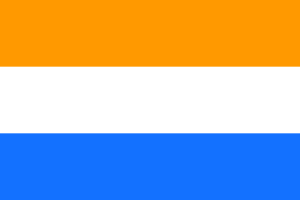Nieuwe Nederlanders | |
|---|---|
 Flag of New Netherland | |
| Regions with significant populations | |
| New York, New Jersey, Delaware | |
| Languages | |
| multiple | |
| Religion | |
| Dutch Reformed | |
| Related ethnic groups | |
| Dutch Americans |
| New Netherland series |
|---|
| Exploration |
| Fortifications: |
| Settlements: |
| The Patroon System |
|
| People of New Netherland |
| Flushing Remonstrance |
 |
New Netherlanders, also known as the Holland Dutch,[1] were residents of New Netherland, the seventeenth-century colonial outpost of the Republic of the Seven United Netherlands on the northeastern coast of North America, centered on the Hudson River and New York Bay, and in the Delaware Valley.
The population of New Netherland was not all ethnically Dutch,[2] but had a variety of ethnic and linguistic backgrounds, including: other European ethnic groups (Germans, Scandinavians, French, Scots, English, Irish, Italians, and Croats); indigenous Amerindian tribes such as Algonquians and Iroquoians; Sephardic Jews (Jews of Spanish and Portuguese backgrounds) both from the Netherlands itself and the then-recently lost colony of Dutch Brazil; and West Africans, the last mostly having been brought as slaves.[3][4][5]
Though the colony officially existed only between 1609 and 1674, the descendants of the original settlers played a prominent role in colonial America. New Netherland culture characterized the region (today's Capital District, Hudson Valley, New York City, western Long Island, northern and central New Jersey, and the Delaware Valley) for two centuries. The concepts of civil liberties and pluralism introduced in the colony are supposed to have later become a mainstay of American political and social life.
- ^ Jaap Jacobs (1887). Year Book of the Holland Society of New-York. Princeton University. pp. 78, 79, 81.
- ^ Un-Pilgrims - Article by Russell Shorto Archived 2008-12-08 at the Wayback Machine
- ^ "Who lived there? :: New Netherland Institute".
- ^ "What was New Netherland?", New Netherland Institute
- ^ Nicoline van der Sijs; Nederlandse Taalunie (2009), Cookies, Coleslaw, and Stoops The Influence of Dutch on the North American Languages, Amsterdam University Press, ISBN 978-90-8964-124-3, JSTOR j.ctt45kf9d
- van der Sijs, Nicoline (2009), Yankees, cookies en dollars De invloed van het Nederlands op de Noord-Amerikaanse talen (PDF), Amsterdam University Press, ISBN 9789089641304
